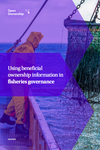Using beneficial ownership information in fisheries governance
Help us understand how you are making use of resources from the Open Ownership website by filling out this short survey
Publication type
Briefing
Publication
Sections
Implementation
Summary
A growing body of publications by civil society and multilateral organisations are calling for beneficial ownership transparency (BOT) in the fisheries sector. However, there remains a gap in the literature in terms of how beneficial ownership (BO) information and central government registers can practically contribute to fisheries governance. Given the number of countries that are implementing BOT for corporate vehicles, it is necessary to look at how ongoing efforts can be leveraged to ensure they result in useful and usable information for the fisheries sector. Perhaps unsurprisingly, as anti-money laundering has been the core policy driver of BOT reforms, much of the initial focus has been on how BOT can tackle fisheries crime and its proceeds. This rather narrow focus fails to include how BOT can help strengthen fisheries-related policies and governance as a whole. In order for the fisheries sector to benefit from the reforms already underway, it is critical to sketch out the potential use cases for BO data and ensure BOT policymakers have a basic understanding of the use cases of BOT in fisheries and engage potential users as part of the reform process.
This briefing explores how BOT can improve the fisheries sector, beyond tackling crime, through the implementation of national, central BO registers. It identifies two principal ways in which BO data can be used to achieve broader policy aims for the fisheries sector. It can help strengthen the governance and oversight of fisheries tenure, and detect and investigate fisheries-related crimes and their proceeds.
Key considerations
- defining beneficial ownership in law, and understanding the conceptual difference between the beneficial ownership of corporate vehicles and that of their underlying assets, such as fishing licences and vessels;
- assessing whether relevant corporate vehicles are sufficiently covered by existing efforts, and how to cover additional corporate vehicles;
- understanding how and at which point to collect data;
- understanding how to structure and make data available to relevant users, including sharing the information across borders, potentially via regional fisheries management organisations.

